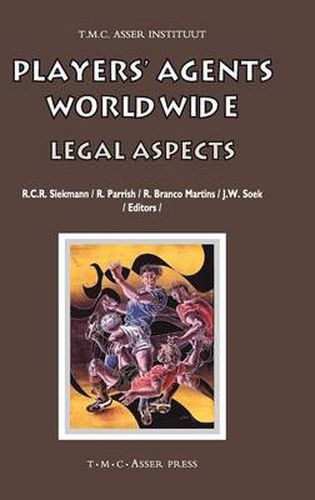Readings Newsletter
Become a Readings Member to make your shopping experience even easier.
Sign in or sign up for free!
You’re not far away from qualifying for FREE standard shipping within Australia
You’ve qualified for FREE standard shipping within Australia
The cart is loading…






This title is printed to order. This book may have been self-published. If so, we cannot guarantee the quality of the content. In the main most books will have gone through the editing process however some may not. We therefore suggest that you be aware of this before ordering this book. If in doubt check either the author or publisher’s details as we are unable to accept any returns unless they are faulty. Please contact us if you have any questions.
With a Foreword by Roger Blanpain, Professor in Labour Law, Universities of Leuven (Belgium) and Tilburg (The Netherlands) and co-founder and first President of FIFPro.
Publicly, at least, there appears to be a strong collective will within football to clean up the game, to make the work of players’ agents more transparent and to allow a greater share of the game’s profits to stay within the game. Privately, there seems to be unease that current agent regulation is out of step with football industry norms and that if the sector is to operate effectively, practices which are prohibited by the rules should in fact be tolerated. Here lies the problem. Stringent agent regulation may well look impressive but over-regulation will merely compound the problem of non-compliance and a lack of transparency. Finding the balance which not only addresses the problems facing football and satisfies the supporters and other interested stakeholders but which also satisfies the requirements of national, EU and international law is just one of the many challenges facing football’s governing bodies.
What are players’ agents? Why should they be regulated? How should they be regulated? These three apparently simple questions have been tackled throughout this book. The first question appears straightforward as agents perform similar functions throughout the world. However, as the contributions in the book reveal, the manner in which agents operate varies. The questions of why and how to regulate again reveals common themes but also considerable variations in patterns of regulation. In this connection, there are, in effect, three tiers of agent regulation: international law, national law and the law of the sports associations.
This book covers the legal regulations governing players’ agents in forty countries around the world, representing the major footballing constituencies including Argentina, Brazil, Mexico and Russia as well as the Big Five in Europe. Written by acknowledged experts, it provides a very useful and informative comparative survey. Indeed, this is a book, which all those involved in the administration of football clubs, particularly, coaches and managers, as well as players’ agents themselves, and commercial, financial and legal advisers, can do hardly do without, as it will provide them with a constant and useful source of reference.
$9.00 standard shipping within Australia
FREE standard shipping within Australia for orders over $100.00
Express & International shipping calculated at checkout
This title is printed to order. This book may have been self-published. If so, we cannot guarantee the quality of the content. In the main most books will have gone through the editing process however some may not. We therefore suggest that you be aware of this before ordering this book. If in doubt check either the author or publisher’s details as we are unable to accept any returns unless they are faulty. Please contact us if you have any questions.
With a Foreword by Roger Blanpain, Professor in Labour Law, Universities of Leuven (Belgium) and Tilburg (The Netherlands) and co-founder and first President of FIFPro.
Publicly, at least, there appears to be a strong collective will within football to clean up the game, to make the work of players’ agents more transparent and to allow a greater share of the game’s profits to stay within the game. Privately, there seems to be unease that current agent regulation is out of step with football industry norms and that if the sector is to operate effectively, practices which are prohibited by the rules should in fact be tolerated. Here lies the problem. Stringent agent regulation may well look impressive but over-regulation will merely compound the problem of non-compliance and a lack of transparency. Finding the balance which not only addresses the problems facing football and satisfies the supporters and other interested stakeholders but which also satisfies the requirements of national, EU and international law is just one of the many challenges facing football’s governing bodies.
What are players’ agents? Why should they be regulated? How should they be regulated? These three apparently simple questions have been tackled throughout this book. The first question appears straightforward as agents perform similar functions throughout the world. However, as the contributions in the book reveal, the manner in which agents operate varies. The questions of why and how to regulate again reveals common themes but also considerable variations in patterns of regulation. In this connection, there are, in effect, three tiers of agent regulation: international law, national law and the law of the sports associations.
This book covers the legal regulations governing players’ agents in forty countries around the world, representing the major footballing constituencies including Argentina, Brazil, Mexico and Russia as well as the Big Five in Europe. Written by acknowledged experts, it provides a very useful and informative comparative survey. Indeed, this is a book, which all those involved in the administration of football clubs, particularly, coaches and managers, as well as players’ agents themselves, and commercial, financial and legal advisers, can do hardly do without, as it will provide them with a constant and useful source of reference.